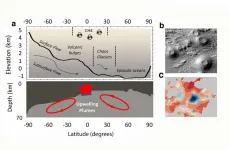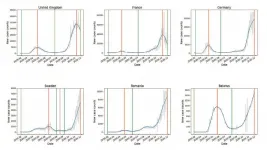Is there life on mars today and where?
Challenging assumptions about the possibility of modern life on Mars
2021-03-16
(Press-News.org) March 16, 2021, Mountain View, CA - In a comment published today in Nature Astronomy, Dr. Nathalie Cabrol, Director of the Carl Sagan Center for Research at the SETI Institute, challenges assumptions about the possibility of modern life on Mars held by many in the scientific community.
As the Perseverance rover embarks on a journey to seek signs of ancient life in the 3.7 billion years old Jezero crater, Cabrol theorizes that not only life could still be present on Mars today, but it could also be much more widespread and accessible than previously believed. Her conclusions are based on years of exploration of early Mars analogs in extreme environments in the Chilean altiplano and the Andes funded by the NASA Astrobiology Institute. It's essential, she argues, that we consider microbial habitability on Mars through the lens of a 4-billion-year-old environmental continuum rather than through frozen environmental snapshots as we tend to do. Also critical is to remember that, by all terrestrial standards, Mars became an extreme environment very early.
In extreme environments, while water is an essential condition, it is far from being enough. What matters most, Cabrol says, it's how extreme environmental factors such as a thin atmosphere, UV radiation, salinity, aridity, temperature fluctuations and many more interact with each other, not only water. "You can walk on the same landscape for miles and find nothing. Then, maybe because the slope changes by a fraction of a degree, the texture or the mineralogy of the soil is different because there is more protection from UV, all of a sudden, life is here. What matters in extreme worlds to find life is to understand the patterns resulting from these interactions". Follow the water is good. Follow the patterns is better.
This interaction unlocks life's distribution and abundance in those landscapes. That does not necessarily make it easier to find, as the last refuges for microbes in extreme environments can be at the micro- to nanoscale within the cracks in crystals. On the other hand, observations made in terrestrial analogs suggest that these interactions considerably expand the potential territory for modern life on Mars and could bring it closer to the surface than long theorized.
If Mars still harbors life today, which Cabrol thinks it does, to find it we must take the approach of Mars as a biosphere. As such, its microbial habitat distribution and abundance are tightly connected not only to where life could theoretically survive today but also where it was able to disperse and adapt over the entire history of the planet, and the keys to that dispersion lie in early geological times. Before the Noachian/Hesperian transition, 3.7-3.5 billion years ago, rivers, oceans, wind, dust storms would have taken it everywhere across the planet. "Importantly, dispersal mechanisms still exist today, and they connect the deep interior to the subsurface," Cabrol says.
But a biosphere cannot run without an engine. Cabrol proposes that the engine to sustain modern life on Mars still exists, that it is over 4 billion years old and migrated out of sight today, underground.
If this correct, these observations may modify our definition of what we call "Special Regions" to include the interaction of extreme environmental factors as a critical element, one that potentially expands their distribution in substantial ways and could have us rethink how to approach them. The issue, here, says Cabrol, is that we do not yet have the global environmental data at a scale and resolution that matters to understand modern microbial habitability on Mars. As human exploration gives us a deadline to retrieve pristine samples, Cabrol suggests options regarding the search for extant life, including the type of missions that could fulfill objectives critical to astrobiology, human exploration, and planetary protection.
INFORMATION:
The work reported here was supported by the NASA Astrobiology Institute via Grant No. NNA15BB01A.
About the SETI Institute
Founded in 1984, the SETI Institute is a non-profit, multi-disciplinary research and education organization whose mission is to explore, understand, and explain the origin and nature of life in the universe and the evolution of intelligence. Our research encompasses the physical and biological sciences and leverages expertise in data analytics, machine learning and advanced signal detection technologies. The SETI Institute is a distinguished research partner for industry, academia and government agencies, including NASA and NSF.
Contact information
Rebecca McDonald?
Director of Communications?
SETI Institute?
rmcdonald@seti.org
[Attachments] See images for this press release:

ELSE PRESS RELEASES FROM THIS DATE:
2021-03-16
Billions of years ago, the Red Planet was far more blue; according to evidence still found on the surface, abundant water flowed across Mars and forming pools, lakes, and deep oceans. The question, then, is where did all that water go?
The answer: nowhere. According to new research from Caltech and JPL, a significant portion of Mars's water--between 30 and 99 percent--is trapped within minerals in the planet's crust. The research challenges the current theory that the Red Planet's water escaped into space.
The Caltech/JPL team found that around four billion years ago, Mars was home to enough water to have covered the whole planet in an ocean about 100 to 1,500 meters deep; a volume roughly ...
2021-03-16
URBANA, Ill. - Corn didn't start out as the powerhouse crop it is today. No, for most of the thousands of years it was undergoing domestication and improvement, corn grew humbly within the limits of what the environment and smallholder farmers could provide.
For its fertilizer needs, early corn made friends with nitrogen-fixing soil microbes by leaking an enticing sugary cocktail from its roots. The genetic recipe for this cocktail was handed down from parent to offspring to ensure just the right microbes came out to play.
But then the Green Revolution changed everything. Breeding tools improved dramatically, leading to faster-growing, higher-yielding hybrids than the world had ...
2021-03-16
Radio telescopes are the world's most sensitive radio receivers, capable of finding extremely faint wisps of radio emission coming from objects at the farthest reaches of the universe. Recently, a team of astronomers used the National Science Foundation's Karl G. Jansky Very Large Array (VLA) to take advantage of a helping hand from nature to detect a distant galaxy that likely is the faintest radio-emitting object yet found.
The discovery was part of the VLA Frontier Fields Legacy Survey, led by NRAO Astronomer Eric Murphy, which used distant clusters of galaxies as natural lenses ...
2021-03-16
Recent research shows that people are more likely to take "microbreaks" at work on days when they're tired - but that's not a bad thing. The researchers found microbreaks seem to help tired employees bounce back from their morning fatigue and engage with their work better over the course of the day.
At issue are microbreaks, which are short, voluntary and impromptu respites in the workday. Microbreaks include discretionary activities such as having a snack, chatting with a colleague, stretching or working on a crossword puzzle.
"A microbreak is, by definition, short," says Sophia Cho, co-author of a paper on the work and an assistant professor ...
2021-03-16
RESEARCH TRIANGLE PARK, N.C. -- Joint Army- and Air Force-funded researchers have taken a step toward building a fault-tolerant quantum computer, which could provide enhanced data processing capabilities.
Quantum computing has the potential to deliver new computing capabilities for how the Army plans to fight and win in what it calls multi-domain operations. It may also advance materials discovery, artificial intelligence, biochemical engineering and many other disciplines needed for the future military; however, because qubits, the fundamental building blocks of quantum computers, are intrinsically fragile, a longstanding barrier to quantum computing has been effective implementation of quantum error correction.
Researchers at University of Massachusetts Amherst, ...
2021-03-16
Corporate strategies should be as unique as possible, in fact highly specific to each individual company. This enables companies to compete successfully in the long term. However, the capital market and others, including analysts, often react negatively to the idea of unique strategies. The reason is that deviating from typical industry standards makes them more complex to evaluate. This regularly discourages companies from focusing on unique strategies, even though they would be beneficial for the company in the long term. This contradiction is known as the "uniqueness paradox". A research team from the Universities of Göttingen and Groningen has investigated the influence of different types of investors on the extent of the paradox and thus on the choice of unique strategies. The results ...
2021-03-16
Higher progesterone level is protective in mild traumatic brain injury
Blood flow in brain is linked to progesterone and stress symptom levels
Most concussion research has been focused on male athletes
CHICAGO --- Could birth control pills help young female athletes recover faster from concussions and reduce their symptoms?
A new Northwestern Medicine pilot study has shown when a female athlete has a concussion injury during the phase of her menstrual cycle when progesterone is highest, she feels less stress. Feeling stressed is one symptom of a concussion. Feeling less stressed is a marker of recovery.
The study also revealed for the first time the physiological reason for the neural protection is increased ...
2021-03-16
New research from the University of Florida Warrington College of Business finds that feeling psychologically powerful makes leaders' jobs seem more demanding. And perceptions of heightened job demands both help and hurt powerful leaders.
Trevor Foulk of the University of Maryland Robert H. Smith School of Business and Klodiana Lanaj, Martin L. Schaffel Professor at UF, note that while power-induced job demands are key to helping leaders more effectively pursue their goals and feel that their jobs are meaningful each day at work, these demands can also cause pain and discomfort, felt in the evening at home.
"Power is generally considered a desirable thing, as leaders often seek power, and it's very rare for leaders to turn powerful roles down," Foulk said. "However, this view is qualified ...
2021-03-16
WASHINGTON, March 16, 2021 -- Sea-based fish farming systems using net pens are hard on the environment and the fish. A closed cage can improve fish welfare, but fresh seawater must be continuously circulated through the cage. However, ocean waves can cause this circulating water to slosh inside the cage, creating violent motions and endangering the cage and the fish.
A study using a scale-model fish containment system is reported in Physics of Fluids, by AIP Publishing. The study shows why violent sloshing motions arise and how to minimize them.
Gentle currents can be artificially maintained inside cylindrical closed cages developed for salmon farming. The current is produced by injecting seawater through ...
2021-03-16
WASHINGTON, March 16, 2021 -- As Europe experienced its enormous second wave of the COVID-19 disease, researchers noticed the mortality rate -- progression from cases to deaths -- was much lower than during the first wave.
This inspired researchers from the University of Sydney and Tsinghua University to study and quantify the mortality rate on a country-by-country basis to determine how much the mortality rate from the second wave decreased from the first.
In Chaos, by AIP Publishing, Nick James, Max Menzies, and Peter Radchenko introduce methods to study the progression of COVID-19 cases to deaths during the pandemic's different waves. Their methods involve applied mathematics, specifically nonlinear dynamics, and time series analysis.
"We take a time series, ...
LAST 30 PRESS RELEASES:
[Press-News.org] Is there life on mars today and where?
Challenging assumptions about the possibility of modern life on Mars



